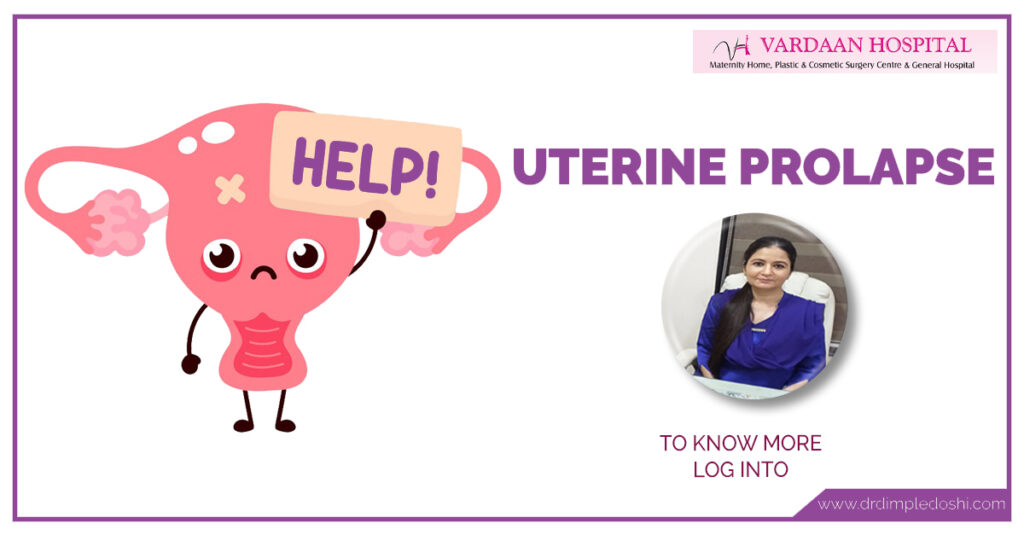
Uterine Prolapse Treatment in Mumbai by Expert Gynecologist
Feeling Pressure or a Bulge Down There? It Could Be Uterine Prolapse.
Do you feel a dragging sensation in your lower pelvis? Noticing something bulging out through the vagina? Do you leak urine while laughing or lifting heavy weights?
These signs could point to uterine prolapse, a common yet under-discussed condition affecting women of all ages—especially those who’ve had vaginal deliveries.
The condition can severely impact your confidence, intimate life, and daily comfort. But the good news is—you don’t have to live with it silently. With the right treatment plan, prolapse can be managed or even reversed.
Globally, 50% of women who’ve had children experience some degree of pelvic organ prolapse during their lifetime. In India, rising awareness is leading more women to seek help early. Source: NCBI
What Is Uterine Prolapse?
Uterine prolapse occurs when the uterus drops from its normal position into or out of the vaginal canal due to weak pelvic floor muscles.
- Often described as “something coming out of the vagina”
- Caused by weak pelvic support after childbirth, aging, or heavy lifting
- May involve other organs like bladder or rectum
What Causes Uterine Prolapse?
Uterine prolapse is caused by stretched or weakened pelvic floor muscles that can no longer support the uterus properly.
- Multiple vaginal deliveries
- Menopause and estrogen deficiency
- Obesity or chronic constipation
- Heavy lifting or long-term coughing
- Genetic weakness in connective tissues
What Are the Symptoms of Uterine Prolapse?
Symptoms vary from mild discomfort to visible bulging through the vaginal opening.
- Heaviness or pulling sensation in the pelvis
- Visible or felt bulge through the vagina
- Urinary issues: leakage, urgency, or retention
- Back pain and constipation
- Discomfort or looseness during intimacy
What Are the 4 Stages of Uterine Prolapse?
Uterine prolapse is graded by how far the uterus has descended into the vaginal canal.
- Stage 1: Mild descent, cervix remains inside the vagina
- Stage 2: Cervix descends to vaginal opening
- Stage 3: Cervix partially protrudes outside the vagina
- Stage 4: Entire uterus is outside the vaginal canal (procidentia)
What Happens if Uterine Prolapse Is Left Untreated?
If left untreated, uterine prolapse can worsen and lead to complications like infections, sores, and even kidney issues.
- Prolapse may worsen with time and strain
- Can lead to bladder (cystocele) or rectum (rectocele) prolapse
- Advanced cases may require surgery (procidentia)
- Can impair kidney function due to ureteral kinking
How Is Uterine Prolapse Diagnosed?
Your gynecologist can diagnose prolapse through a physical pelvic examination and evaluate its severity.
- Speculum exam for visual assessment
- Urine flow and post-void residual tests if urinary issues exist
- Pelvic ultrasound or MRI for detailed evaluation
How Do You Treat Uterine Prolapse?
Treatment depends on the severity, age, and reproductive plans. It can be managed surgically or non-surgically.
- Pelvic floor exercises: Kegels to strengthen muscles
- Pessary: A removable device that supports the uterus
- Surgical options:
- Vaginal hysterectomy with prolapse repair
- Uterine suspension via laparoscopy or vaginal route
Can Uterine Prolapse Be Prevented?
While not always preventable, lifestyle changes and exercises can reduce your risk of uterine prolapse.
- Perform Kegel exercises daily
- Avoid constipation with fiber-rich diet
- Don’t lift heavy weights without support
- Treat chronic cough or bronchitis promptly
Medical Codes for Uterine Prolapse
ICD-10 Codes for Uterine Prolapse
| ICD-10 Code | Description |
|---|---|
| N81.0 | Uterine prolapse, unspecified |
| N81.1 | Cystocele (anterior vaginal wall prolapse) |
| N81.2 | Incomplete uterovaginal prolapse |
| N81.3 | Complete uterovaginal prolapse |
| N81.4 | Uterovaginal prolapse with cystocele |
| N81.6 | Rectocele (posterior vaginal wall prolapse) |
| N81.9 | Female genital prolapse, unspecified |
CPT Codes for Uterine Prolapse Treatment
| CPT Code | Description |
|---|---|
| 57250 | Colpopexy, abdominal approach (fixation of vaginal apex) |
| 57260 | Combined anterior and posterior colporrhaphy (repair for cystocele and rectocele) |
| 57265 | Combined anteroposterior colporrhaphy with enterocele repair |
| 57280 | Sacrocolpopexy, abdominal approach (often for uterine prolapse) |
| 57282 | Colpopexy, vaginal approach, extraperitoneal |
| 57283 | Colpopexy, vaginal approach, intraperitoneal |
| 58150 | Total abdominal hysterectomy (if performed for uterine prolapse) |
| 58570 | Laparoscopic total hysterectomy (for prolapse cases) |
FAQs – Uterine Prolapse
Q1. How does a prolapse start?
Ans. A prolapse usually starts after pelvic muscle weakening due to childbirth, aging, or hormonal changes during menopause.
Q2. Can I fix a vaginal prolapse without surgery?
Ans. Yes, mild prolapse may improve with Kegel exercises, lifestyle changes, or a vaginal pessary prescribed by your doctor.
Q3. How do I check myself for prolapse?
Ans. You may feel a bulge or heaviness in your vaginal area. However, a proper pelvic exam by a gynecologist is essential for accurate diagnosis.
Q4. What are the 4 stages of uterine prolapse?
Ans. The stages range from slight descent (Stage 1) to complete prolapse outside the vaginal opening (Stage 4).
Q5. Can a prolapse correct itself?
Ans. Mild cases may improve with pelvic floor therapy, but moderate to severe prolapse usually requires medical intervention.
Q6. What is the best position to sleep with prolapse?
Ans. Sleeping on your back with a pillow under the knees can reduce pressure on pelvic organs.
Q7. Why do I feel heaviness in my uterus?
Ans. A feeling of pelvic heaviness is a common symptom of prolapse due to weakened pelvic support structures.
Q8. Can prolapse affect my sex life?
Ans. Yes, some women experience discomfort or reduced sensation. Treatment can restore comfort and intimacy.
Q9. Is walking or skipping bad for prolapse?
Ans. Gentle walking is beneficial. Avoid high-impact exercises like skipping unless cleared by your doctor.
Q10. How many Kegel exercises should I do daily?
Ans. Start with 10 reps, 3 times a day. Gradually increase as your pelvic muscles strengthen.
Take charge of your health today.
Book your consultation with Dr. Dimple Doshi at Vardaan Hospital, Goregaon West, Mumbai.

